Has The Subprime Auto Bubble Burst?
It looks like the subprime auto loan bubble has popped.
Last year, we reported that the auto industry’s check engine light was on. Now it looks like the thing is totally breaking down. Small subprime auto lenders are starting to go belly-up due to increasing losses and defaults. As ZeroHedgenoted, “we all know what comes next: the larger companies go bust, inciting real capitulation.”
Bloomberg recently reported that not only are subprime auto lenders facing tough business conditions, there are also allegations of fraud and under-reporting of losses.
Growing numbers of small subprime auto lenders are closing or shutting down after loan losses and slim margins spur banks and private equity owners to cut off funding. Summit Financial Corp., a Plantation, Florida-based subprime car finance company, filed for bankruptcy late last month after lenders including Bank of America Corp. said it had misreported losses from soured loans. And a creditor to Spring Tree Lending, an Atlanta-based subprime auto lender, filed to force the company into bankruptcy last week, after a separate group of investors accused the company of fraud. Private equity-backed Pelican Auto Finance, which specialized in ‘deep subprime’ borrowers, finished winding down last month after seeing its profit margins shrink.”
We’ve heard this song and seen this dance before. As Bloomberg noted, the pain among small auto lenders “parallels with the subprime mortgage crisis last decade, when the demise of finance companies like Ownit Mortgage and Sebring Capital Partners were a harbinger that bigger losses for the financial system were coming.”
The common denominator here: rising interest rates. Easy money pumped up both the housing and auto loan bubble. When the Fed takes away the punchbowl, bubbles burst.
Chris Gillock works as an analyst for Colonnade Advisors, focusing on subprime auto investments. His description of the auto loan industry sounds a lot like mortgage lending back in the years leading up to the housing bust.
There’s been a lot of generosity and not a lot of discretion on the part of lenders and investors. There’s going to be more capitulation.”
Auto loans to subprime borrowers have hit delinquency rates not seen since 2010. The number of borrowers behind on payments has been increasing steadily since 2012. In the third quarter of 2017, nearly 10% of auto loans extended to consumers with a credit score of less than 620 were 90 days or more behind.
In another bad sign for the auto market, subprime borrowers have gone missing from auto showrooms. According to Bloomberg, rising interest rates and rapidly increasing vehicle prices are squeezing consumers with shaky credit and tight budgets out of the market. Even the most creditworthy consumers aren’t showing up to dealerships.
In the first two months of this year, sales were flat among the highest-rated borrowers, while deliveries to those with subprime scores slumped 9%, according to J.D. Power. The researcher’s data highlights what’s happening beneath the surface of a US auto market in its second year of decline after a historic run of gains. Automakers probably will report sales in March slowed to the most sluggish pace since Hurricane Harvey ravaged dealerships across the Texas Gulf Coast in August, according to Bloomberg’s survey of analyst estimates.”
Americans simply can’t afford to buy vehicles. ZeroHedge compiled a number of statistics that reveal just how unhealthy the automobile market in the US has become.
-
The average price for a new vehicle is at a record high $31,099.
-
The average price of a used car is a record high $19, 589.
-
The average monthly payment for new and used cars has hit a record high of $515 per month.
-
The average auto loan has hit a record high of 69 months.
Notice the theme here — record high.
ZeroHedge summed it all up.
Cheap credit leads to easy lending conditions, and record prices as everyone floods into the market with lenders hardly discriminating who they give money to.”
And then the bubble pops.
The collapse of the subprime auto industry probably won’t have the same impact on the economy as the housing crash did in 2008. The industry isn’t as big in terms of dollars. But what’s going on in the auto industry is indicative of broader trends in the US economy. It’s not the only bubble.
Reprinted from SchiffGold.com.







 Peter Schiff is the CEO and Chief Global Strategist of Euro Pacific Capital, best-selling author and host of syndicated Peter Schiff Show.
Peter Schiff is the CEO and Chief Global Strategist of Euro Pacific Capital, best-selling author and host of syndicated Peter Schiff Show. 
